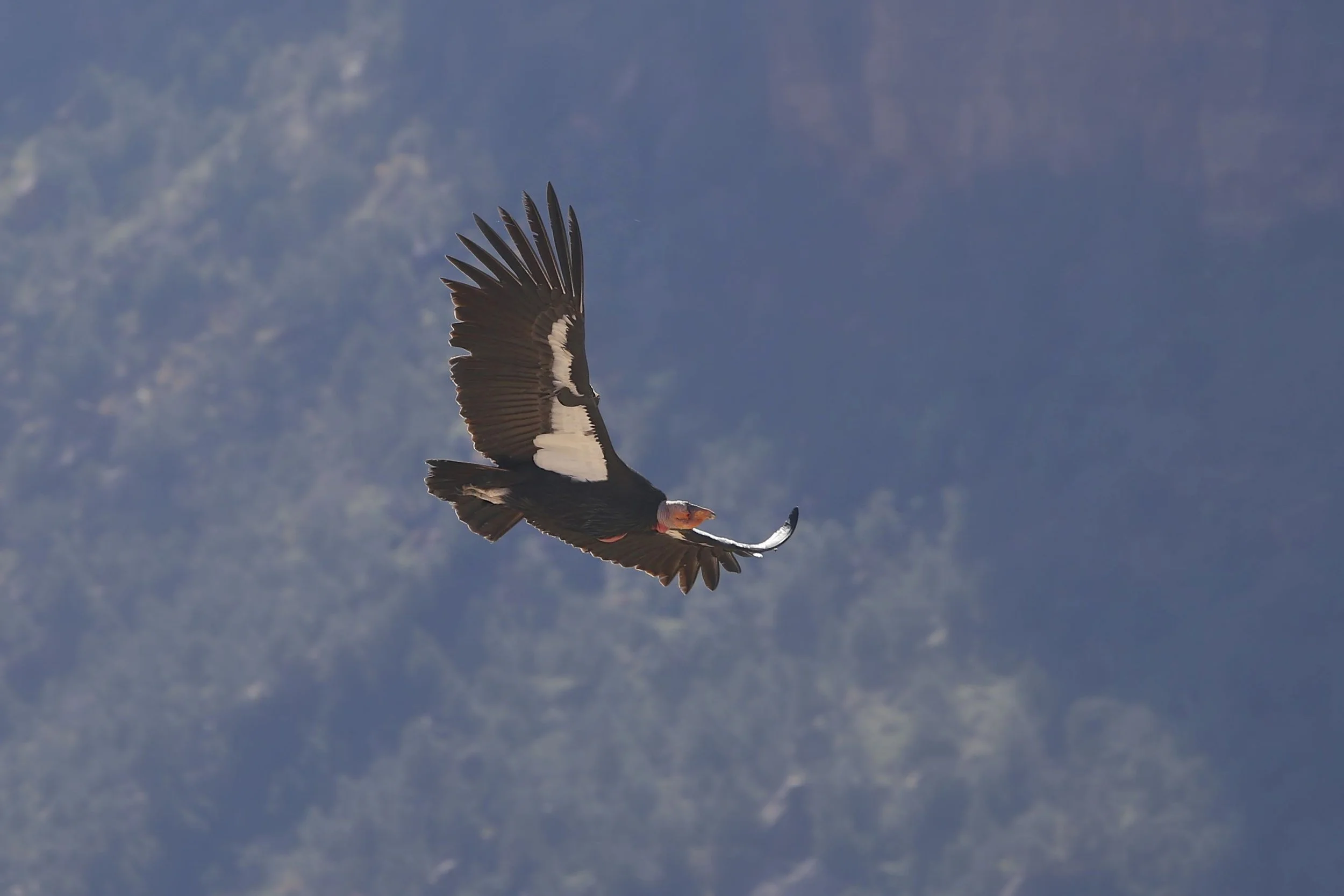CALIFORNIA CONDOR
California condors (Gymnogyps Californianus) are a New World vulture of the Cathartidae family. The condors have wingspans up to 9 feet, and weigh 16-31 pounds. Breeding maturity can be reached as early as the fifth year, and adults can be distinguished from juveniles by the orange coloration on the head and neck, and white panels on the underside of the wings. California condors are primarily monomorphic, making it hard to distinguish males from females at a distance except for the slightly larger size of the males.
Pursuant to the Condor Recovery Program identification system, condor # 1 has an estimated hatch year of 1966, showing that California condors can live in captivity at least 45 years (and counting).
One of the primary causes of the condor’s decline in North America began with the loss of megafauna ten to twelve thousand years ago. Further, the increase in whaling activities in the 1800s decreased the availability of large carcasses on the west coast, which was the mainstay of the California condor’s diet. Since that time, numerous activities have exacerbated the condor’s decline, including, harvests made by Native American for religious ceremonies and trade, scientific collection in the late 19th Century, and cattle ranching around the remaining condor ranges in Central and Southern California.
Increased development in California in the post-World War II era further reduced habitat and food sources of the condor. Additional factors such as reduction in the size of cattle ranches and cattle as a new food source, power lines and the use of insecticides like DDT all had detrimental effects on the California condors. As a result, the condors’ population declined to near extinction in the 1980s.
Condors were first listed as protected species in California in 1967, and were federally listed under the Endangered Species Act (ESA) in 1973. As of April of 2011, there were some 394 California condors in the world population, with roughly half in captivity. While condors located in California are listed as endangered, a number of condors released in Arizona and Utah are classified as section 10(j)-nonessential/experimental, as that term is defined under the ESA, to the survival of the species.
All current free-flying California condors are descendants of captive breeding in the Condor Recovery Program initiated in the early 1980s. All original remaining wild, free-flying condors captured by 1987 remain in captivity. While the breeding program started off with 5 wild and inter-related females in 1987, all captive and free-flying condors are primarily descendants of just 4 females, Condors # 10, 11, 12, and 13. Thus, the possibility of a genetic bottleneck contributing to the eventual demise of the species is extremely high, and a natural recovery may not be possible due solely to the genetic factor.
In the wild, mature California condors lay eggs once every other year. In captivity, California condors have been induced to produce 2 or 3 eggs in each successive season by the process of “double clutching” or “triple clutching.” In double clutching, the laid egg is removed from the artificial nest early enough that the female is capable of laying a second or in some cases a third egg, in the same season.
Naturally laid eggs can encounter failure rates between 50-100%. Captive laid eggs under human supervision have had greater than 50% failure rates, despite intensive veterinary monitoring. Hunt for Truth has learned through intensive research that the widespread use of DDT, other organochlorine pesticides, and certain rodenticides throughout the remaining condor habitat in Central and Southern California had serious and significant impacts on condor populations. The resulting adverse impact on egg survival rates due to pesticide exposure, coupled with a natural breeding cycle where condors only lay eggs naturally once every two years, population losses to inadequate food, and collisions with power lines and other building structures, have contributed to serious declines in the population by the late 1960s.
Hunt for Truth has also found that federal and state officials have long been aware of historical adverse impacts on condors by DDT and DDE pesticide residues. Hunt for Truth has uncovered that federal and state officials permitted the re-release of endangered California condors into the environment for “recovery” purposes, with the full knowledge that the historical DDT and DDE threat had not been mitigated.
Ventana Wildlife Society, a Condor Recovery Program partner, considers exposure to elevated levels of DDE to be the key threat to meeting condor recovery goals in California along the Big Sur Coast. The fact that Condor Recovery Program personnel at both the federal and the state levels had access to this information, combined with the fact that they are currently encountering egg-shell thinning related to DDE exposure, may mean that the knowing release of California condors into these hazardous geographies violates the ESA.
Since the designation of the California condor as endangered and the intervention by the Condor Recovery Program, there has been a significant controversy over the alleged poisoning and mortality of the condors, claimed to be linked to the ingestion of lead. While some researchers maintain that lead ammunition from gutpiles or game carrion left in the field by hunters is the primary source of lead exposure to condors, there is compelling evidence of alternative sources of lead in the environment. Such alternative sources of lead include paint chips from old buildings, legacy leaded gasoline in soils, mining wastes, old insecticides and microtrash.
One such noted exposure to an alternative source of lead in the environment was discovered at Pinnacles National Monument, where condors # 317 and 318 were observed ingesting lead paint fragments from the North Chalone Fire Lookout Tower. In turn, these parents fed the regurgitated lead paint fragments to their fledgling (# 550). Condors # 317, 318 and 550 were all tested and found to have high blood-lead levels, while # 550 had to be evacuated to the Los Angeles Zoo for intense treatment for lead poisoning.
The first condor to be identified as a lead-related mortality was Condor # 19 in March of 1984. According to the condor’s medical file, no forensic analysis was performed on a 7-8mm metallic fragment reportedly recovered from the “gizzard,” though necropsy personnel reported being able to cut the fragment with a metal scalpel.
Rarely, if ever, has an actual projectile fragment been found in the digestive tract of a California condor. However, objects that were thought to be projectile fragments were subsequently found to be pieces of gravel or a “woody” substance, not from ammunition. Hunt for Truth has discovered that many of these researchers “cherry picked” this information, deleting it and often refusing to present the underlying information to scientific peer review, policy makers and the public at large. This activity by the researchers calls their very claims and conclusions into serious question.
The purported link between the use of lead ammunition and the poisoning and/or mortality in condors is further weakened by the failure of California’s lead ban to successfully combat lead poisoning in wildlife. Assembly Bill (AB) 821 was passed out by the California Legislature on September 5, 2007 and enrolled September 10, 2007. Governor Arnold Schwarzenegger signed AB 821 on October 13, 2007, just after the Concord Fish and Game Commission hearing which banned the use of lead centerfire ammunition while hunting big game in the condor range. The bill was predicated and passed on its proponents’ assurances that hunters’ lead ammunition was the cause of lead related poisoning and deaths in California condors.
Since the passage of AB 821, the California Department of Fish and Game wardens have surveyed the types of ammunition used by hunters in the Condor Zones during hunting season, where the use of lead ammunition is banned. Despite 98.89% hunter compliance with AB 821, the 2009, 2010, and 2011 condor blood-lead data, collected by the Condor Recovery Program in California, shows that the incidence of lead exposure and poisoning in condors remains static and actually increased slightly.
Hunt for Truth believes that the combination of: 1) the 2009, 2010, and 2011 blood lead data; 2) the passage of AB 821, and; 3) the Department of Fish and Game’s evidence of 98.89% hunter compliance with the lead ban, strongly indicate that hunters’ ammunition is not the cause of lead exposure and toxicity in condors and alternative sources of lead are to blame.
Those attempting to impede hunters’ rights through the prohibition of traditional ammunition consisting of lead components have used the California condor as a propaganda tool to advance their campaign. Hunt for Truth continues to investigate the truth about the purported nexus between traditional ammunition and lead poisoning and/or mortality in California condors.


